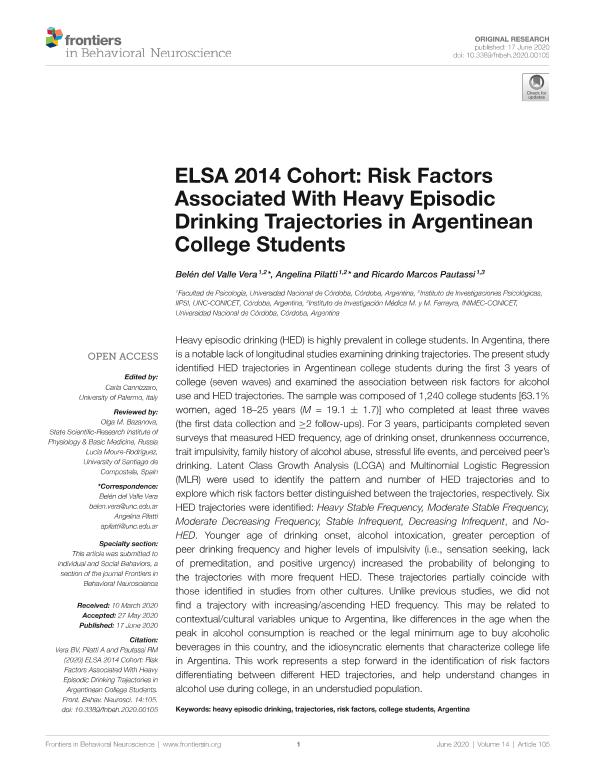Artículo
ELSA 2014 Cohort: Risk Factors Associated With Heavy Episodic Drinking Trajectories in Argentinean College Students
Fecha de publicación:
17/06/2020
Editorial:
Frontiers Media
Revista:
Frontiers in Behavioral Neuroscience
ISSN:
1662-5153
Idioma:
Inglés
Tipo de recurso:
Artículo publicado
Clasificación temática:
Resumen
Heavy episodic drinking (HED) is highly prevalent in college students. In Argentina, there is a notable lack of longitudinal studies examining drinking trajectories. The present study identified HED trajectories in Argentinean college students during the first 3 years of college (seven waves) and examined the association between risk factors for alcohol use and HED trajectories. The sample was composed of 1,240 college students [63.1% women, aged 18–25 years (M = 19.1 ± 1.7)] who completed at least three waves (the first data collection and ≥2 follow-ups). For 3 years, participants completed seven surveys that measured HED frequency, age of drinking onset, drunkenness occurrence, trait impulsivity, family history of alcohol abuse, stressful life events, and perceived peer’s drinking. Latent Class Growth Analysis (LCGA) and Multinomial Logistic Regression (MLR) were used to identify the pattern and number of HED trajectories and to explore which risk factors better distinguished between the trajectories, respectively. Six HED trajectories were identified: Heavy Stable Frequency, Moderate Stable Frequency, Moderate Decreasing Frequency, Stable Infrequent, Decreasing Infrequent, and No-HED. Younger age of drinking onset, alcohol intoxication, greater perception of peer drinking frequency and higher levels of impulsivity (i.e., sensation seeking, lack of premeditation, and positive urgency) increased the probability of belonging to the trajectories with more frequent HED. These trajectories partially coincide with those identified in studies from other cultures. Unlike previous studies, we did not find a trajectory with increasing/ascending HED frequency. This may be related to contextual/cultural variables unique to Argentina, like differences in the age when the peak in alcohol consumption is reached or the legal minimum age to buy alcoholic beverages in this country, and the idiosyncratic elements that characterize college life in Argentina. This work represents a step forward in the identification of risk factors differentiating between different HED trajectories, and help understand changes in alcohol use during college, in an understudied population.
Palabras clave:
ARGENTINA
,
COLLEGE STUDENTS
,
HEAVY EPISODIC DRINKING
,
RISK FACTORS
,
TRAJECTORIES
Archivos asociados
Licencia
Identificadores
Colecciones
Articulos (IIPSI)
Articulos de INSTITUTO DE INVESTIGACIONES PSICOLOGICAS
Articulos de INSTITUTO DE INVESTIGACIONES PSICOLOGICAS
Articulos(INIMEC - CONICET)
Articulos de INSTITUTO DE INV. MEDICAS MERCEDES Y MARTIN FERREYRA
Articulos de INSTITUTO DE INV. MEDICAS MERCEDES Y MARTIN FERREYRA
Citación
Vera, Belén del Valle; Pilatti, Angelina; Pautassi, Ricardo Marcos; ELSA 2014 Cohort: Risk Factors Associated With Heavy Episodic Drinking Trajectories in Argentinean College Students; Frontiers Media; Frontiers in Behavioral Neuroscience; 14; 17-6-2020; 1-11
Compartir
Altmétricas




